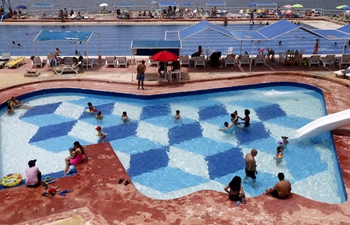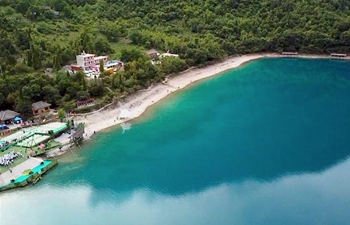HAVANA, June 16 (Xinhua) -- Lazara Dranguet was delighted when she received a loan from the government to rebuild her destroyed house, thanks to a policy started by former President Raul Castro and continued by his successor Miguel Diaz-Canel.
Dranguet lost her apartment in the old quarter of Havana when a neighbor's gas stove blew up, burning the entire building down to the ground.
The waitress in a government agency cafeteria and her family then joined the ranks of 880,000 families suffering from Cuba's housing shortage, with nearly a quarter of them in Havana alone.
After months of paperwork, she was granted 90,000 Cuban pesos (90,000 U.S. dollars) and a piece of land where she could build a new home on her own, a policy encouraged by Castro to speed up solutions to the shortage.
"My husband is very skilled in construction, so he has been doing all the masonry and we are saving on labor, which is much more expensive than the construction materials," Dranguet told Xinhua recently.
For the last 20 years, Cuba has faced an economic crisis which, combined with the U.S. embargo, has crippled the local construction materials industry.
Access to the few materials available is hampered by unscrupulous individuals who hoard them to resell them at a huge mark-up.
"Getting cement is the biggest problem, it flies out of (state-owned) shops where it is sold at 6 CUC (six dollars) but then people re-sell it to you at 12 (12 dollars), or even 20 CUC (20 dollars)," Dranguet said.
According to the National Statistics Bureau, in 2016, the island manufactured only 29 percent of the construction materials it had produced at its peak in 1989.
The cement industry is designed to manufacture about 5 million tons a year, but in 2016, Cuba produced only 1.4 million tons.
To make things worse, the island is frequently hit by hurricanes, which increases the number of people affected.
Castro foresaw that resolving the housing deficit through state management alone would be an impossible mission and encouraged Cubans to construct and repair their homes on their own.
To facilitate that, he authorized banks to grant low-interest loans to those who could build or repair their homes, and non-refundable loans to poorer people or those on welfare.
Roberto Fernandez, 59, a hydraulic engineer, joined the thousands of families who have benefited from the policy.
Fernandez applied for a loan to buy a plot of land and received 40,000 CUC (40,000 dollars) on 3 percent interest to be repaid over 10 years.
"Every year I can apply for a new credit if necessary. I just need to make payments back to the bank on a regular basis... Already... my house is almost finished," he told Xinhua with a big smile.
The housing deficit is considered the worst social problem facing Cuba since demographic growth over the last half century has been bigger that the construction rate.
According to government figures issued in 2017, Cuba has a shortage of 883,050 dwellings and must build 44,000 housing a year for the next two decades. This rate seems highly unlikely, considering the current pace of 10,000 houses a year.

















